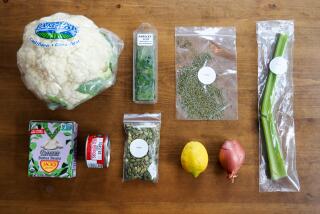Some Cereal Makers Cling to Preservatives
Question: Why, with all of the high-tech packaging films available, do major cereal companies still add the preservatives BHT and BHA to cereal? I do not purchase their products for that reason, but I miss the cereals of my childhood.
GARY HASCAL
Answer: There is no question that, with all of the new packaging technologies available, many foods, including cereals, could eliminate preservatives such as BHT (butylated hydroxytoluene) and BHA (butylated hydroxyanisole).
But the cost of these films (and the subsequent price increase to the consumer) poses a problem, according to the Kellogg Co. Furthermore, the companyâs surveys have found that consumers typically have several opened boxes of cereals in their homes at any one time, and the time lapse between packaging and consumption of these cereals, in Kelloggâs opinion, requires the use of preservatives in many cereals.
Nevertheless, some of the companyâs products, as well as some products from other major cereal companies, are preservative-free. Brands found in health food stores, such as Barbaraâs, Natureâs Path, Zoe Foods and Richard Scary Organics, are also typically free of preservatives.
Incidentally, the just-released Food Marketing Instituteâs Consumer Attitudes in 2000 Report finds that consumers who seek out preservative-free brands are willing to pay the additional cost for this benefit.
*
Q: We love to eat out, but with all the food safety problems I am concerned about getting food poisoning. Any tips?
LORRAINE SMOOT
A: The federal Centers for Disease Control and Prevention reports that last year there were an estimated 76 million illnesses from food-borne illnesses, so your concern is valid. Almost 80% of these occurrences are bacterial, with improper holding temperatures and poor personal hygiene of food handlers (which includes people preparing their own foods at home) contributing the most to disease incidence.
The first tip is to always check out the restaurant before you go in. Look for the letter grade posted by the health department, and read the health inspection reports and violations published in many local newspapers.
Second, look around the restaurant to see if it is clean. Health inspectors and chefs agree that a clean bathroom is usually an indicator of the cleanliness of the rest of the restaurant--and when visiting a restaurant for the first time, it should be your first stop. Overflowing trash, stopped up drains or a lack of hot water and soap in the restroom usually indicate that the restaurant isnât paying attention to fundamental cleanliness.
Third, inspect your food carefully before you eat. Improper food temperatures, according to both the CDC and the National Restaurant Assn., are the No. 1 cause of food illness. Avoid meats that are bloody or rare, chicken that is pink or bloody, eggs that are runny, shellfish that does not have the shell open or fish that doesnât flake to the fork. Donât ever be shy about sending food back to the kitchen to be recooked.
For more restaurant food safety tips, go to the National Restaurant Assn. Web site at https://www.restaurant.org or the Partnership for Food Safety at https://www.fightbac.org.
*
Phil Lempert is the food correspondent for NBCâs âTodayâ show. He welcomes questions about healthful food shopping but regrets that he cannot respond to every query. He can be reached by e-mail at [email protected]. or by writing Before You Bite, Los Angeles Timesâ Health section, 202 W. First St., Los Angeles, CA 90012.
More to Read
Eat your way across L.A.
Get our weekly Tasting Notes newsletter for reviews, news and more.
You may occasionally receive promotional content from the Los Angeles Times.










